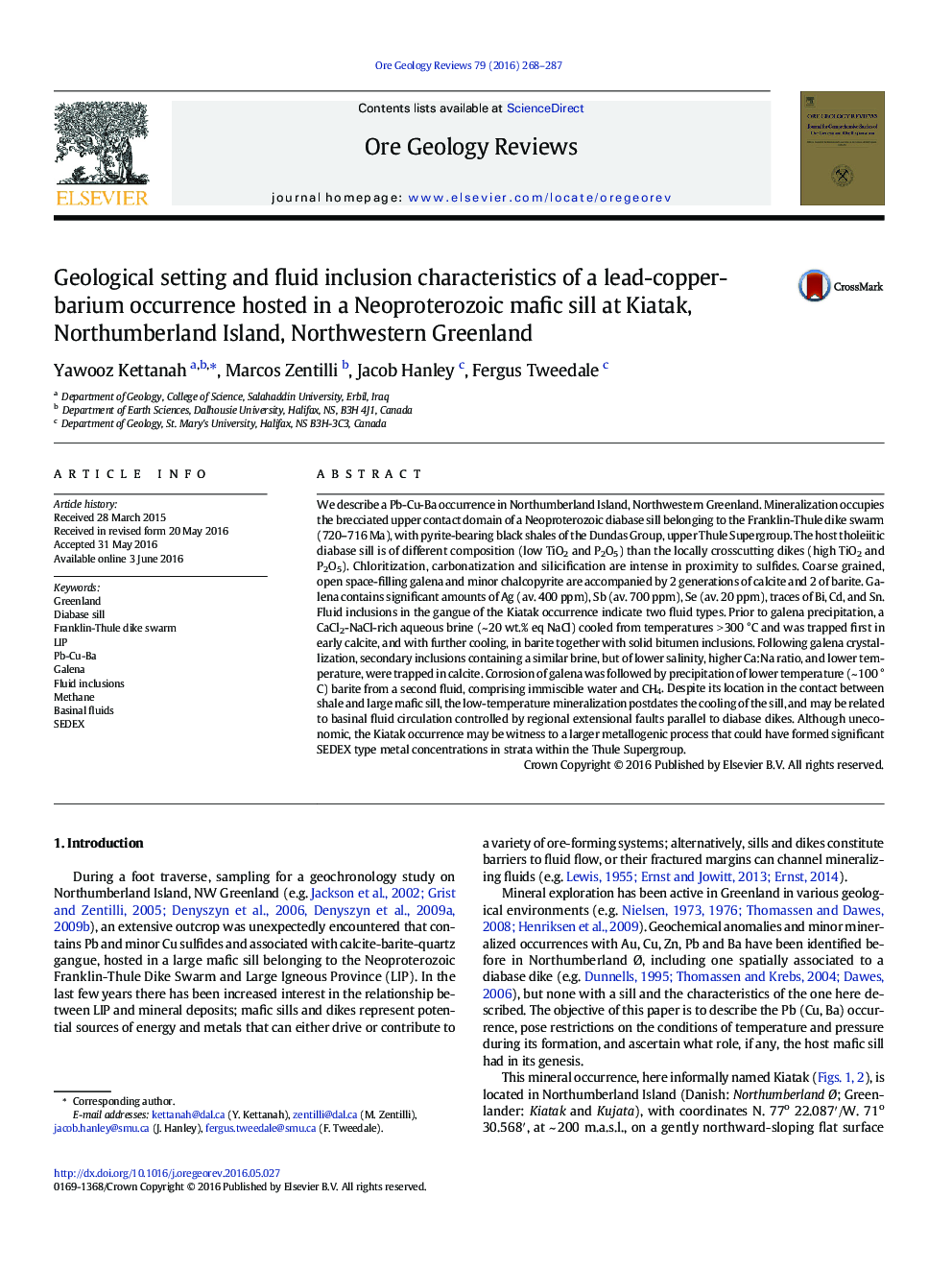| کد مقاله | کد نشریه | سال انتشار | مقاله انگلیسی | نسخه تمام متن |
|---|---|---|---|---|
| 4696797 | 1637227 | 2016 | 20 صفحه PDF | دانلود رایگان |

• First documentation of geological controls of new Pb locality in western Greenland
• Galena, chalcopyrite, calcite and barite localized on the upper contact of a Proterozoic diabase sill.
• The Kiatak host sill is composed of tholeiitic basalt with oceanic and within plate affinity.
• Galena show zoning and contains significant amounts of Sb, Ag, and less Se and traces of Bi, Fe, Ba, Cd, Ni, and Sn.
• Fluid inclusions in the gangue of the Kiatak occurrence indicate two fluid types with Th ranging between slightly < 100 to > 300oC.
• Fluid inclusion also indicate a post-mineralization event with circulation of methane-bearing low-salinity fluids at temperature around 100oC.
• Mineralization is interpreted to be the result of basinal processes during basin inversion.
• The Kiatak galena occurrence is not economic but it may be an indication of larger base metal deposits with SEDEX or MVT affinities in the area.
We describe a Pb-Cu-Ba occurrence in Northumberland Island, Northwestern Greenland. Mineralization occupies the brecciated upper contact domain of a Neoproterozoic diabase sill belonging to the Franklin-Thule dike swarm (720–716 Ma), with pyrite-bearing black shales of the Dundas Group, upper Thule Supergroup. The host tholeiitic diabase sill is of different composition (low TiO2 and P2O5) than the locally crosscutting dikes (high TiO2 and P2O5). Chloritization, carbonatization and silicification are intense in proximity to sulfides. Coarse grained, open space-filling galena and minor chalcopyrite are accompanied by 2 generations of calcite and 2 of barite. Galena contains significant amounts of Ag (av. 400 ppm), Sb (av. 700 ppm), Se (av. 20 ppm), traces of Bi, Cd, and Sn. Fluid inclusions in the gangue of the Kiatak occurrence indicate two fluid types. Prior to galena precipitation, a CaCl2-NaCl-rich aqueous brine (~ 20 wt.% eq NaCl) cooled from temperatures > 300 °C and was trapped first in early calcite, and with further cooling, in barite together with solid bitumen inclusions. Following galena crystallization, secondary inclusions containing a similar brine, but of lower salinity, higher Ca:Na ratio, and lower temperature, were trapped in calcite. Corrosion of galena was followed by precipitation of lower temperature (~ 100 °C) barite from a second fluid, comprising immiscible water and CH4. Despite its location in the contact between shale and large mafic sill, the low-temperature mineralization postdates the cooling of the sill, and may be related to basinal fluid circulation controlled by regional extensional faults parallel to diabase dikes. Although uneconomic, the Kiatak occurrence may be witness to a larger metallogenic process that could have formed significant SEDEX type metal concentrations in strata within the Thule Supergroup.
Figure optionsDownload as PowerPoint slide
Journal: Ore Geology Reviews - Volume 79, December 2016, Pages 268–287